1995 GMC SIERRA ESP
[x] Cancel search: ESPPage 294 of 488
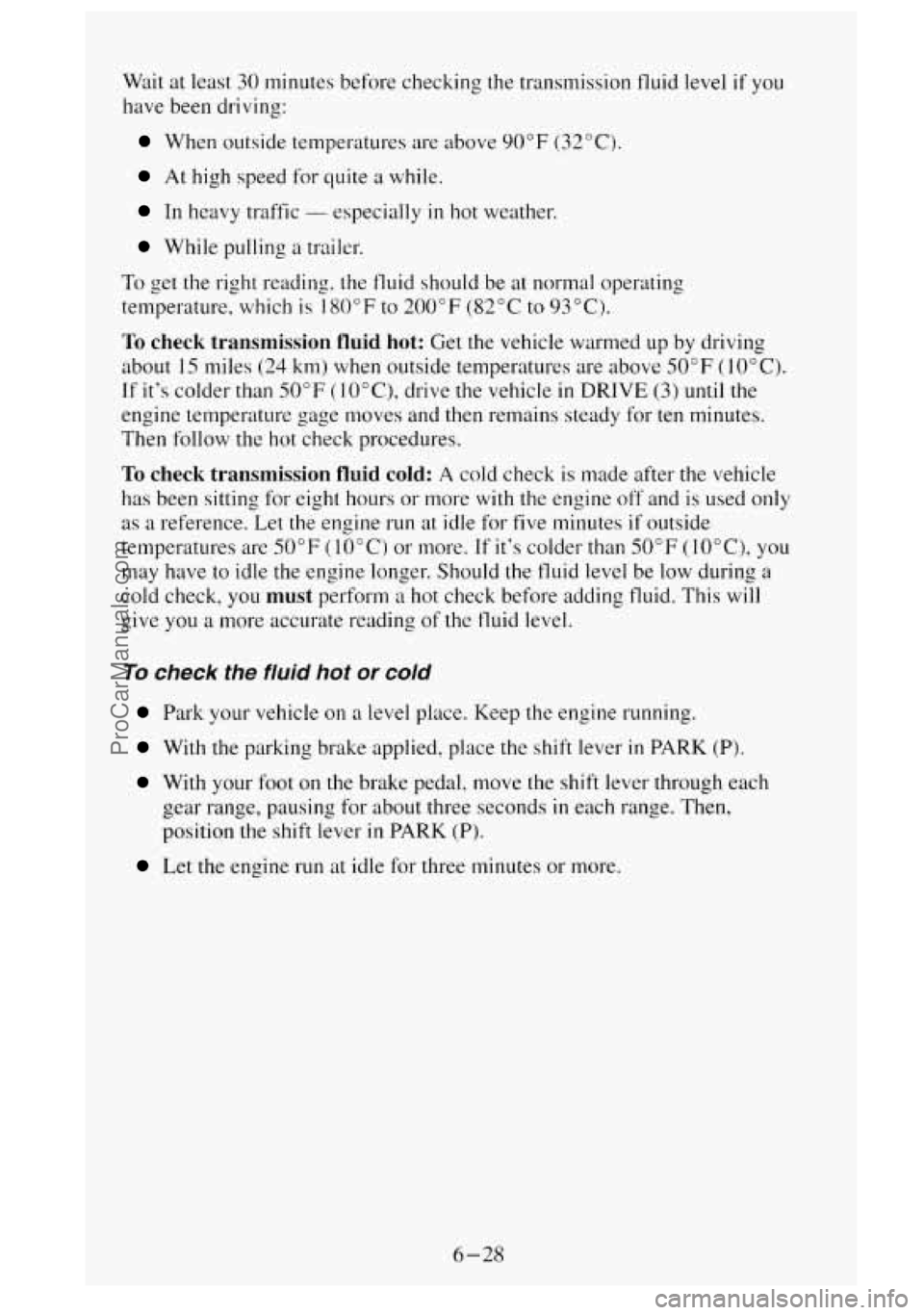
Wait at least 30 minutes before checking the transmission fluid level if you
have been driving:
When outside temperatures are above 90°F (32°C).
At high speed for quite a while.
In heavy traffic - especially in hot weather.
While pulling a trailer.
To get the right reading. the fluid should be at normal operating
temperature, which is 180°F to 200°F
(82°C to 93°C).
To check transmission fluid hot: Get the vehicle warmed up by driving
about
15 miles (24 km) when outside temperatures are above 50°F (10°C).
If it's colder than 50°F (lO"C), drive the vehicle in DRIVE (3) until the
engine temperature gage moves and then remains steady for ten minutes.
Then follow the hot check procedures.
To check transmission fluid cold: A cold check is made after the vehicle
has been sitting for eight hours or more
with the engine off and is used only
as a reference. Let the engine run at idle for five minutes if outside
temperatures are 50°F
(10°C) or more. If it's colder than 50°F (IOOC), you
may have to idle the engine longer. Should the fluid level be low during a
cold check, you
must perform a hot check before adding fluid. This will
give you a more accurate reading of the fluid level.
To check the fluid hot or cold
Park your vehicle on a level place. Keep the engine running.
With the parking brake applied, place the shift lever in PARK (P).
With your foot on the brake pedal, move the shift lever through each
gear range, pausing for about three seconds
in each range. Then,
position the shift lever
in PARK (P).
Let the engine run at idle for three minutes or more.
6-28
ProCarManuals.com
Page 296 of 488
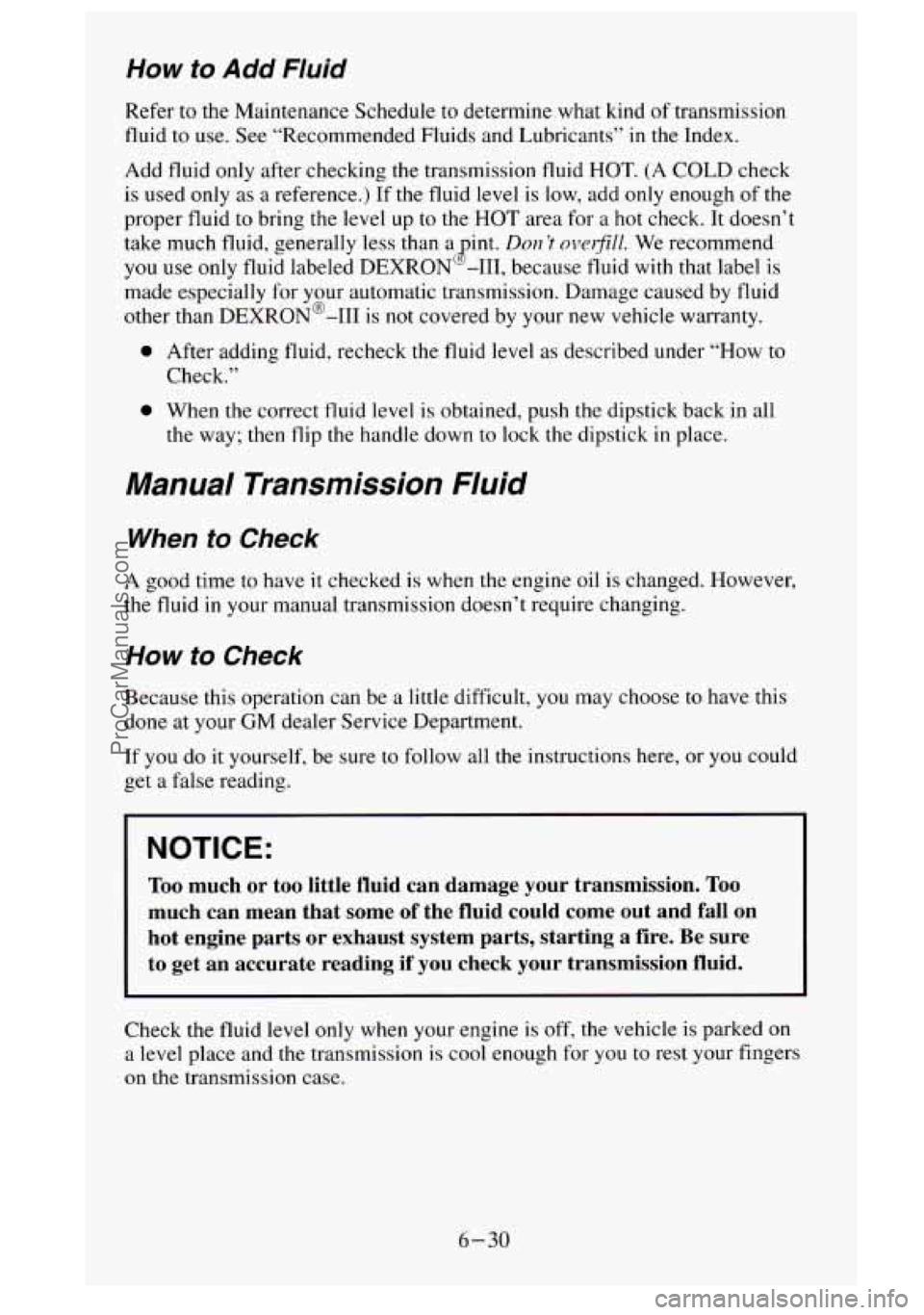
How to Add Fluid
Refer to the Maintenance Schedule to determine what kind of transmission
fluid
to use. See “Recommended Fluids and Lubricants” in the Index.
Add fluid only after checking the transmission fluid
HOT. (A COLD check
is used
only as a reference.) If the fluid level is low, add only enough of the
proper fluid to bring the level up
to the HOT area for a hot check. It doesn’t
take much fluid, generally less than a
int. Don ’t overfill. We recommend
you use only fluid labeled DEXRON
-111, because fluid with that label is
made especially for your automatic transmission. Damage caused by fluid
other than DEXRON@-I11 is not covered by your
new vehicle warranty.
8
0 After adding fluid, recheck the fluid level as described under “How to
Check.”
0 When the correct fluid level is obtained, push the dipstick back in all
the way; then flip the handle down
to lock the dipstick in place.
Manual Transmission Fluid
When to Check
A good time to have it checked is when the engine oil is changed. However,
the fluid
in your manual transmission doesn’t require changing.
How to Check
Because this operation can be a little difficult, you may choose to have this.
done at your
GM dealer Service Department.
If you do it yourself, be sure to follow all the instructions here, or you could
get a false reading.
NOTICE:
Too much or too little fluid can damage your transmission. Too
much can mean that some of the fluid could come out and fall on
hot engine parts or exhaust system parts, starting a fire.
Be sure
to get an accurate reading if you check your transmission fluid.
Check the fluid level only when your engine is off, the vehicle is parked on
a level place and the transmission is cool enough for you to rest your fingers
on the transmission case.
6-30
ProCarManuals.com
Page 325 of 488
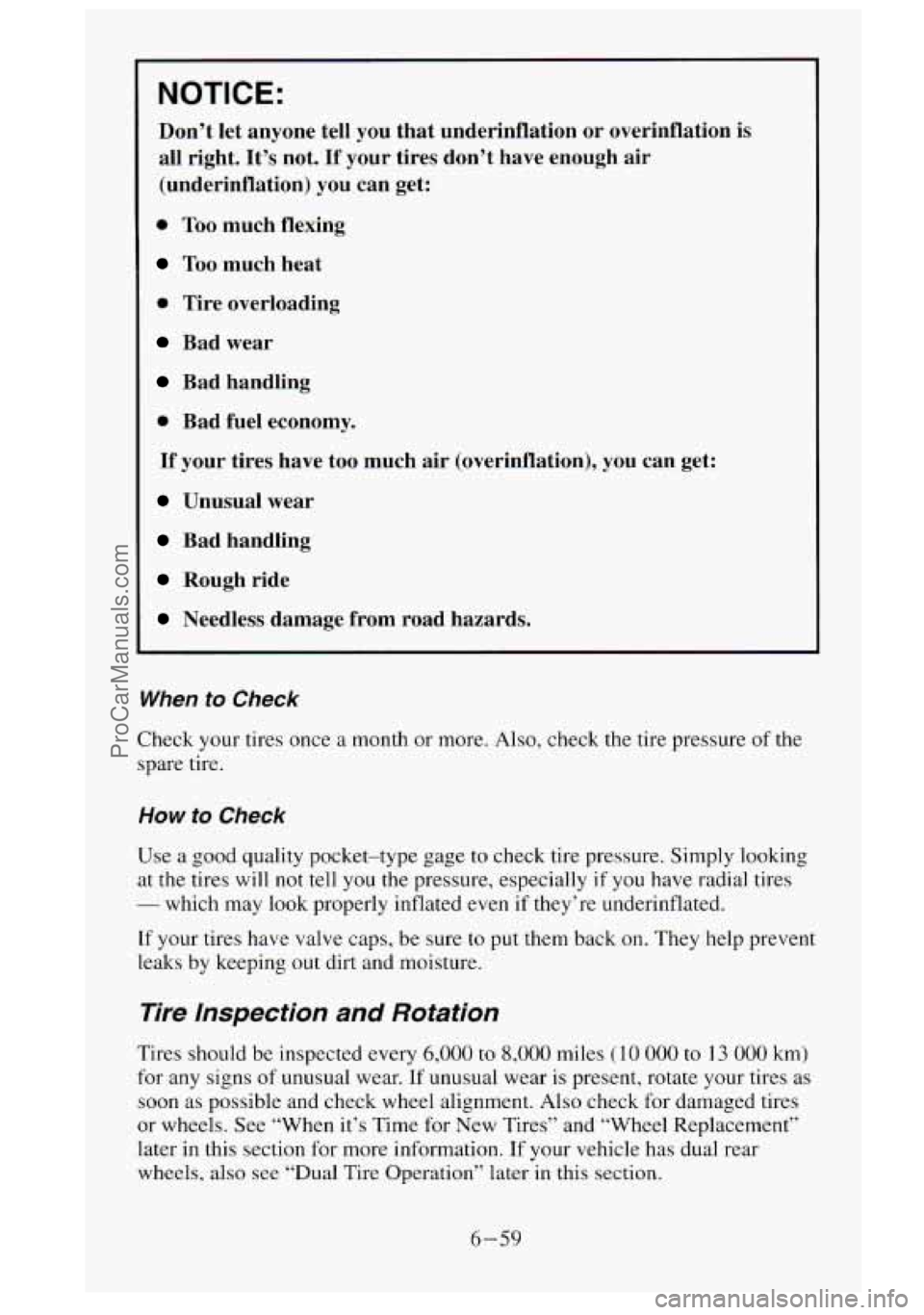
NOTICE:
Don’t let anyone tell you that underinflation or overinflation is
all right. It’s not.
If’ your tires don’t have enough air
(underinflation)
you can get:
0 Too much flexing
Too much heat
0 Tire overloading
Bad wear
Bad handling
0 Bad fuel economy.
If your tires have too much air (overinflation), you can get:
Unusual wear
Bad handling
Rough ride
Needless damage from road hazards.
When to Check
Check your tires once a month or more. Also, check the tire pressure of the
spare tire.
How to Check
Use a good quality pocket-type gage to check tire pressure. Simply looking
at the tires will not tell you the pressure, especially
if you have radial tires
- which may look properly inflated even if they’re underinflated.
If your tires have valve caps, be sure to put them back on. They help prevent
leaks by keeping out dirt and moisture.
Tire Inspection and Rotation
Tires should be inspected every 6,000 to 8,000 miles (10 000 to 13 000 km)
for any signs of unusual wear. If unusual wear is present, rotate your tires as
soon as possible and check wheel alignment. Also check for damaged tires
or wheels. See “When it’s Time for New Tires” and “Wheel Replacement”
later in this section for more information.
If your vehicle has dual rear
wheels, also see
“Dual Tire Operation” later in this section.
6-59
ProCarManuals.com
Page 330 of 488
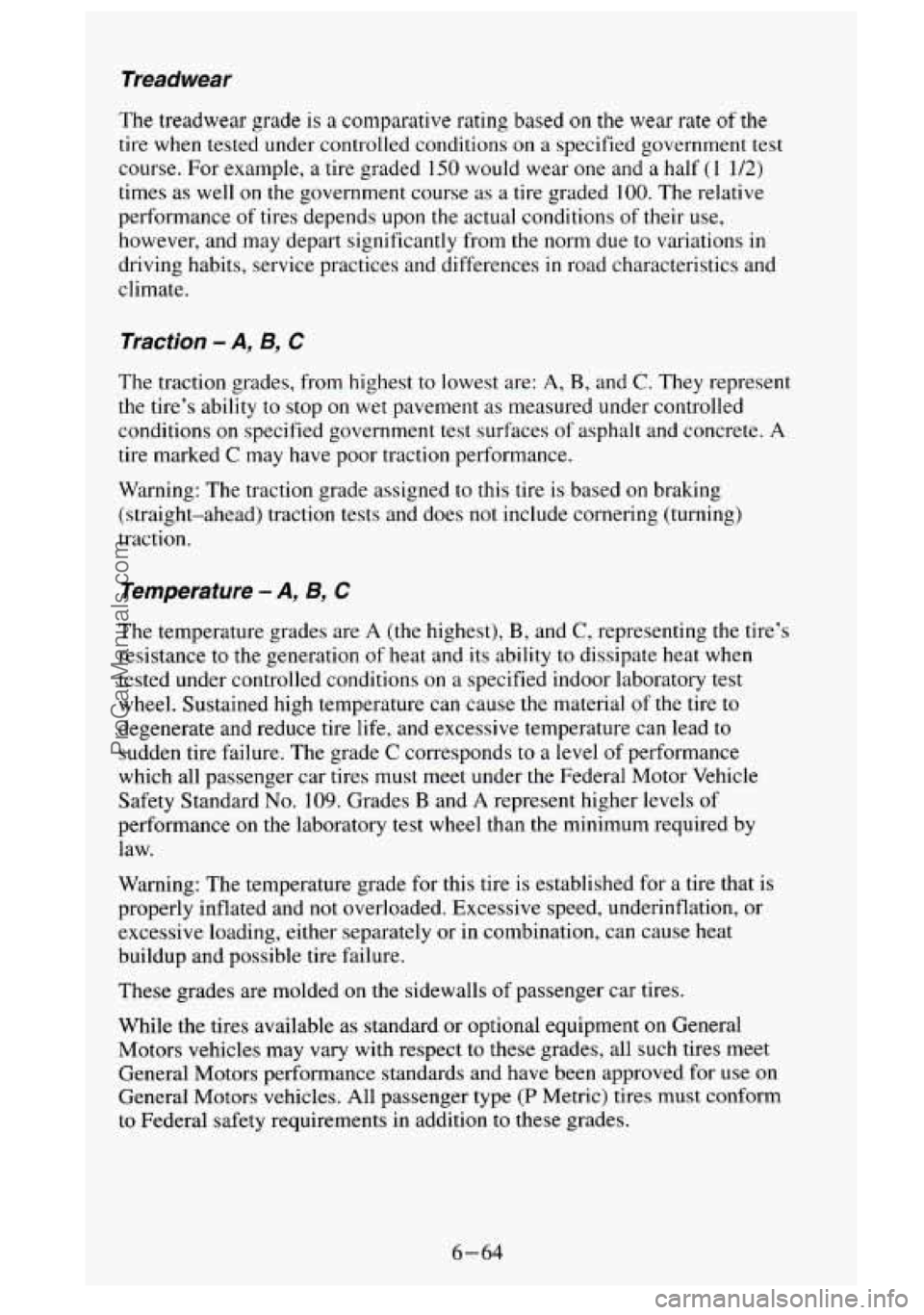
Treadwear
The treadwear grade is a comparative rating based on the wear rate of the
tire when tested under controlled conditions on
a specified government test
course. For example,
a tire graded 150 would wear one and a half (1 1/2)
times as well on the government course as a tire graded 100. The relative
performance
of tires depends upon the actual conditions of their use,
however, and may depart significantly from the norm due to variations
in
driving habits, service practices and differences in road characteristics and
climate.
Traction - A, B, C
The traction grades, from highest to lowest are: A, B, and C. They represent
the tire’s ability to stop on wet pavement
as measured under controlled
conditions on specified government test surfaces of asphalt and concrete.
A
tire marked C may have poor traction performance.
Warning: The traction grade assigned to this tire
is based on braking
(straight-ahead) traction tests and does not include cornering (turning)
traction.
Temperature - A, B, C
The temperature grades are A (the highest), B, and C, representing the tire’s
resistance to the generation
of heat and its ability to dissipate heat when
tested under controlled conditions on a specified indoor laboratory test
wheel. Sustained high temperature can cause the material
of the tire to
degenerate and reduce tire life, and excessive temperature can lead
to
sudden tire failure. The grade C corresponds to a level of performance
which all passenger car tires must meet under the Federal Motor Vehicle
Safety Standard
No. 109. Grades B and A represent higher levels of
performance
on the laboratory test wheel than the minimum required by
law.
Warning: The temperature grade for this tire is established for a tire that is
properly inflated and
not overloaded. Excessive speed, underinflation, or
excessive loading, either separately or in combination, can cause heat
buildup and possible tire failure.
These grades are molded on the sidewalls of passenger car tires.
While the tires available as standard or optional equipment on General
Motors vehicles may vary with respect to these grades, all such tires meet
General Motors performance standards and have been approved for use on
General Motors vehicles.
All passenger type (P Metric) tires must conform
to Federal safety requirements in addition to these grades.
6-64
ProCarManuals.com
Page 461 of 488
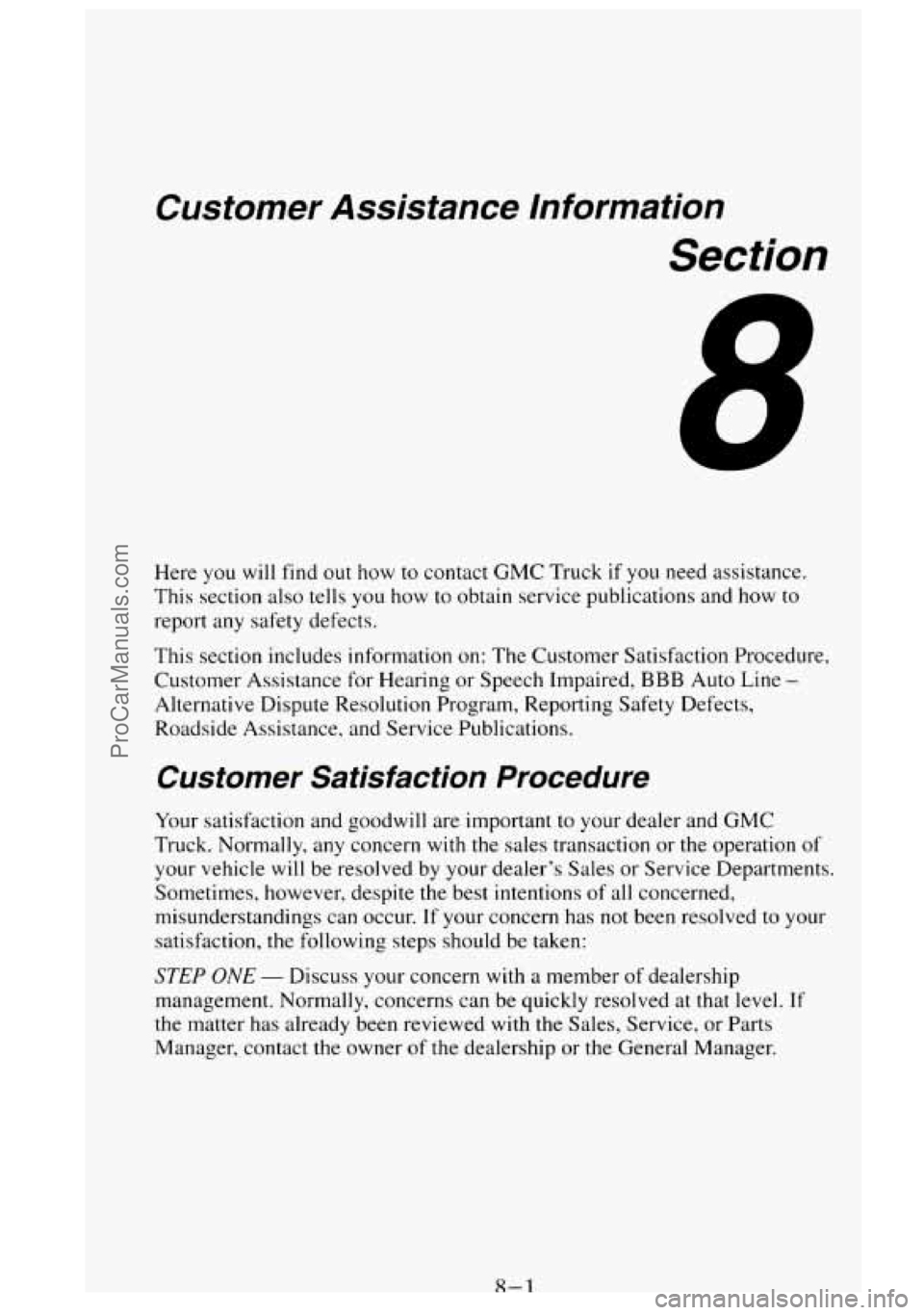
Customer Assistance Information
Section
Here you will find out how to contact GMC Truck if you need assistance.
This section also tells you how to obtain service publications and how to
report any safety defects.
This section includes information on:
The Customer Satisfaction Procedure,
Customer Assistance for Hearing or Speech Impaired,
BBB Auto Line -
Alternative Dispute Resolution Program, Reporting Safety Defects,
Roadside Assistance. and Service Publications.
Customer Satisfaction Procedure
Your satisfaction and goodwill are important to your dealer and GMC
Truck. Normally, any concern with
the sales transaction or the operation of
your vehicle will be resolved by your dealer’s Sales or Service Departments.
Sometimes, however, despite the best intentions
of all concerned,
misunderstandings can occur.
If your concern has not been resolved to your
satisfaction,
the following steps should be taken:
STEP ONE - Discuss your concern with a member of dealership
management. Normally, concerns can be quickly resolved at that level.
If
the matter has already been reviewed with the Sales, Service, or Parts
Manager, contact the owner of the dealership or the General Manager.
8-1
ProCarManuals.com
Page 465 of 488
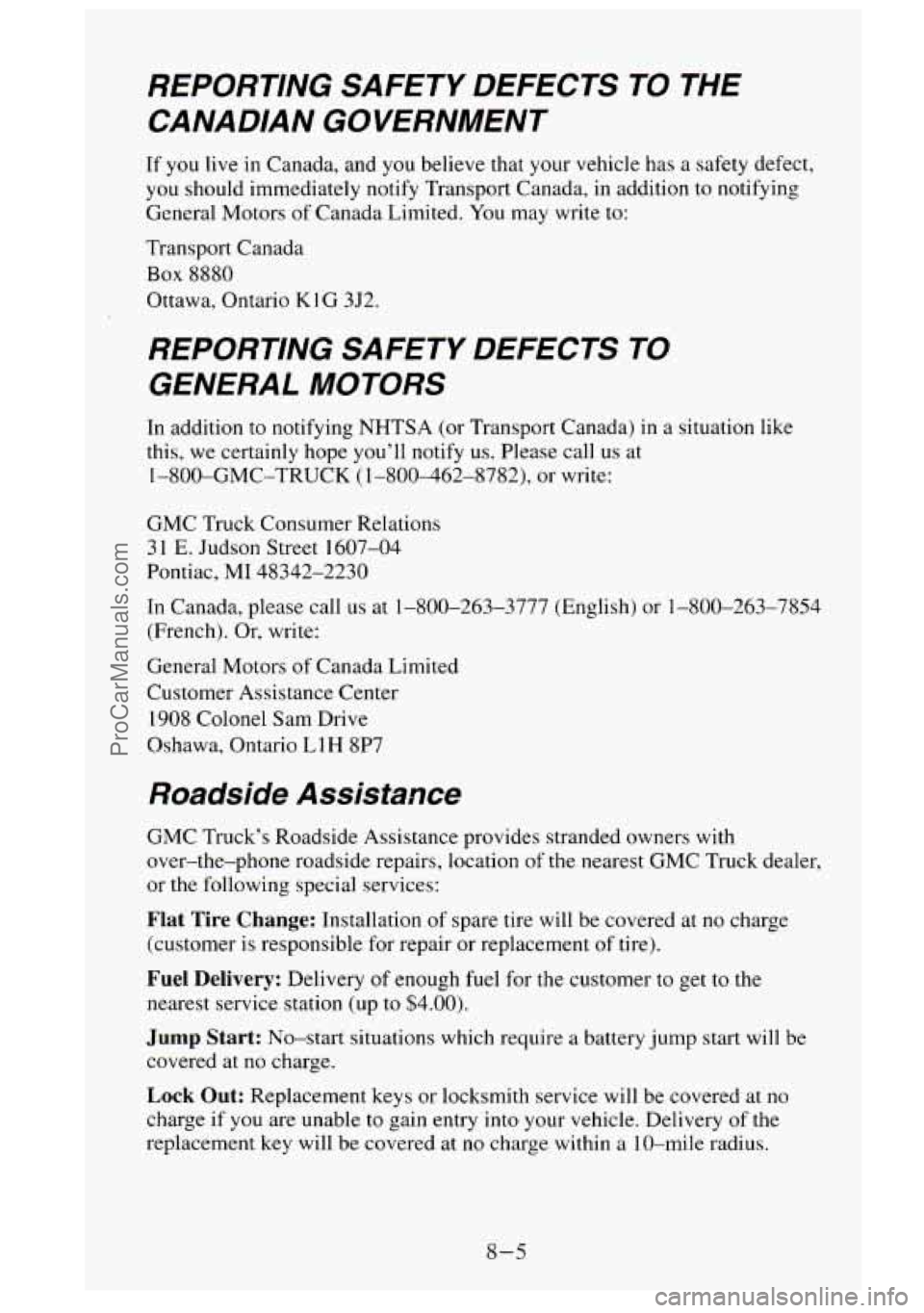
REPORTING SAFETY DEFECTS TO THE
CANADIAN GOVERNMENT
If you live in Canada, and you believe that your vehicle has a safety defect,
you should immediately notify Transport Canada, in addition
to notifying
General Motors of Canada Limited.
You may write to:
Transport Canada
Box 8880
Ottawa, Ontario K1 G 352.
REPORTING SAFETY DEFECTS TO GENERAL MOTORS
In addition to notifying NHTSA (or Transport Canada) in a situation like
this, we certainly hope
you’ll notify us. Please call us at
1-800-GMC-TRUCK (1-800-462-8782), or write:
GMC Truck Consumer Relations
3
1 E. Judson Street 1607-04
Pontiac, MI 48342-2230
In Canada, please call
us at 1-800-263-3777 (English) or 1-800-263-7854
(French). Or, write:
General Motors of Canada Limited
Customer Assistance Center
1908 Colonel Sam Drive
Oshawa, Ontario
LlH 8P7
Roadside Assistance
GMC Truck’s Roadside Assistance provides stranded owners with
over-the-phone roadside repairs, location of the nearest GMC Truck dealer,
or the following special services:
Flat Tire Change: Installation of spare tire will be covered at no charge
(customer
is responsible for repair or replacement of tire).
Fuel Delivery: Delivery of enough fuel for the customer to get to the
nearest service station (up to $4.00).
Jump Start: No-start situations which require a battery jump start will be
covered at
no charge.
Lock Out: Replacement keys or locksmith service will be covered at no
charge if you are unable to gain entry into your vehicle. Delivery of the
replacement key will be covered at no charge within a 10-mile radius.
8-5
ProCarManuals.com
Page 475 of 488
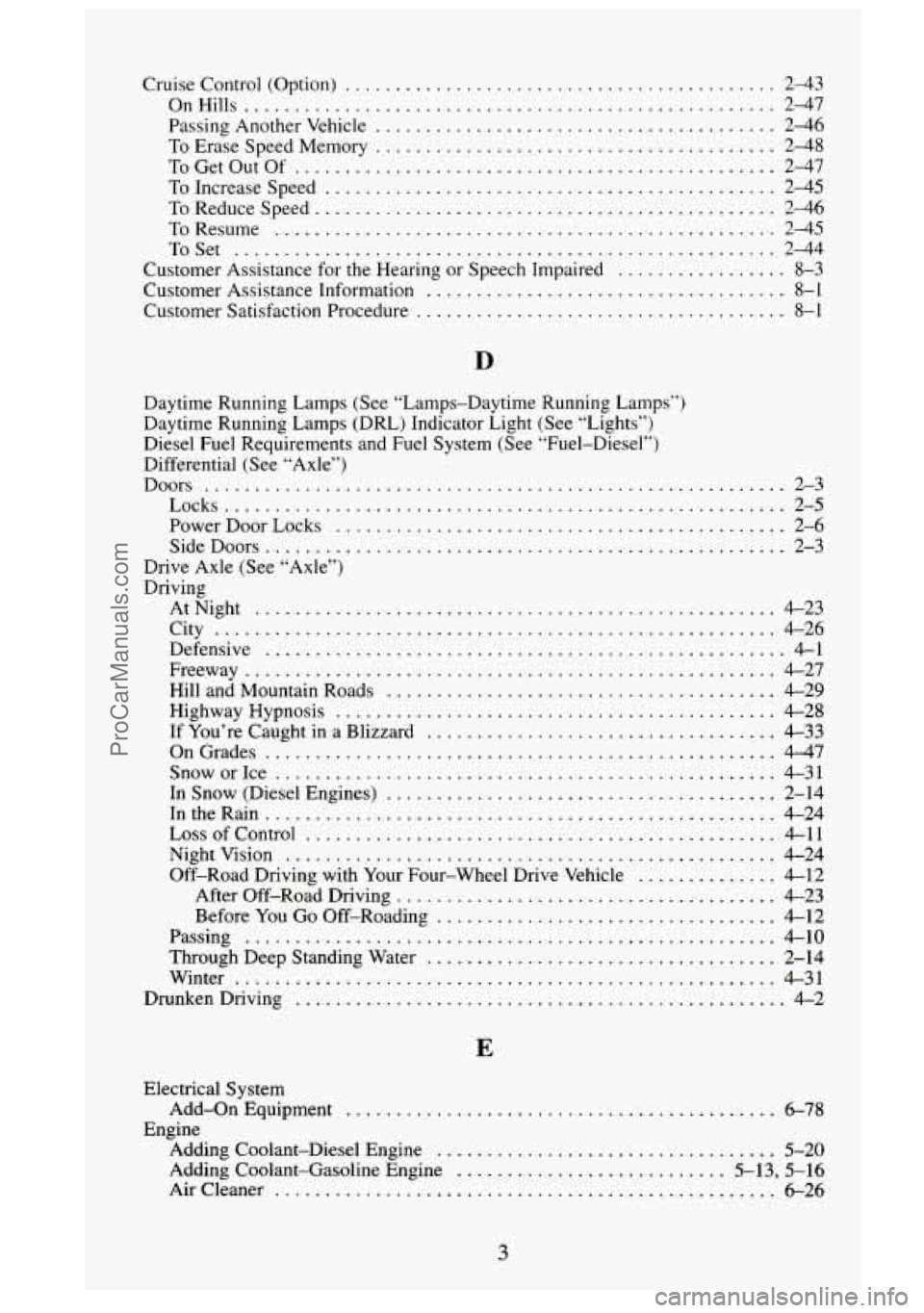
Cruise Control (Option) ........................................... 2-43
OnHills
..................................................... 2-47
Passing Another Vehicle
........................................ 2-46
To Erase Speed Memory
........................................ 2-48
ToGetOutOf ................................................ 2-47
ToIncreaseSpeed
............................................. 2-45
ToReduceSpeed
.............................................. 2-46
ToResume
.................................................. 2-45
ToSet ...................................................... 2-44
Customer Assistance for the Hearing or Speech Impaired
................. 8-3
Customer Assistance Information
.................................... 8-1
Customer Satisfaction Procedure ..................................... 8-1
Daytime Running Lamps (See “Lamps-Daytime Running Lamps”)
Daytime Running Lamps (DRL) Indicator Light (See “Lights”)
Diesel Fuel Requirements and Fuel System (See “Fuel-Diesel”)
Differential (See “Axle”) Doors
.......................................................... 2-3
Locks
........................................................ 2-5
PowerDoorLocks
............................................. 2-6
SideDoors
.................................................... 2-3
Drive Axle (See
“Axle”)
Driving AtNight
.................................................... 4-23
City
........................................................ 4-26
Defensive
.................................................... 4-1
Freeway ..................................................... 4-27
HillandMountainRoads
....................................... 4-29
Highway Hypnosis
............................................ 4-28
If You’re Caught in a Blizzard
................................... 4-33
OnGrades
................................................... 447
SnoworIce
.................................................. 4-31
In Snow (Diesel Engines) ....................................... 2-14
IntheRain
................................................... 4-24
LossofControl
............................................... 4-11
Nightvision
................................................. 4-24
Off-Road Driving with Your Four-wheel Drive Vehicle
.............. 4-12
After Off-Road Driving
...................................... 4-23
Before
You Go Off-Roading .................................. 4-12
Passing
..................................................... 4-10
Through Deep Standing Water ................................... 2-14
Winter ...................................................... 4-31
DrunkenDriving ................................................. 4-2
Electrical System
Engine Add-on Equipment
........................................... 6-78
Adding
Coolant-Diesel Engine .................................. 5-20
Adding Coolant-Gasoline Engine ........................... 5-13. 5-16
Aircleaner .................................................. 6-26
3
ProCarManuals.com